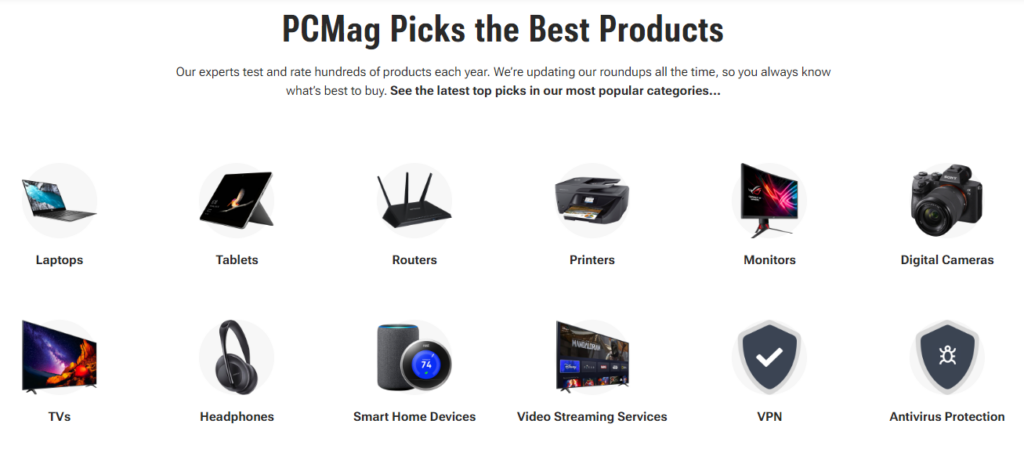Affiliate marketing is a great way to monetize your web traffic and earn additional income. It’s a versatile stream of revenue that you can leverage no matter what your industry or niche.
Affiliate marketing has evolved into a multibillion-dollar industry, showing no signs of slowing down. By the end of 2024, global affiliate marketing spending is set to escalate to $15.7 billion. This rapid growth underscores the increasing reliance on affiliate marketing by businesses worldwide as they connect with consumers in the expanding eCommerce landscape. Furthermore, with an estimated 9,600 affiliate-related services and companies worldwide, the opportunities for new affiliates are vast and varied.
In this guide, we’ll cover everything from the basics to advanced strategies, helping you navigate affiliate marketing and capitalize on its potential. Whether you’re just starting out or looking to refine your existing efforts, this guide will provide you with the knowledge and tools you need to succeed in affiliate marketing.
What Is Affiliate Marketing?
Affiliate marketing is the process of promoting and selling another company’s products or services for a commission. It’s a simple enough concept, but the process itself can involve a lot of moving pieces. At its core, though, affiliate marketing simply means that you sell someone else’s stuff and earn money for it.
How Does Affiliate Marketing Work?
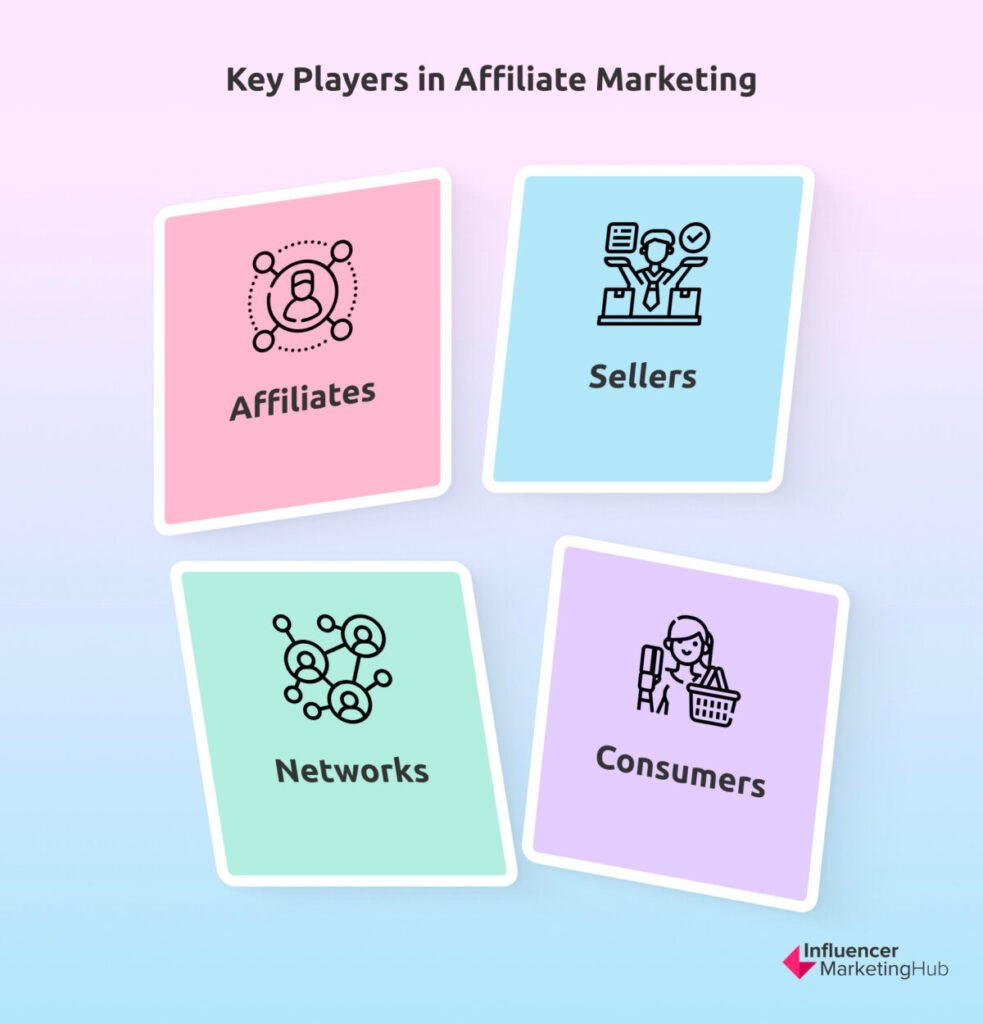
Affiliate marketing might seem straightforward, but it involves several key players and processes that work together to create a successful system. Understanding these components is crucial to grasping how affiliate marketing operates. Here, we’ll break down the essential parts: the Merchant, the Affiliate Marketer, the Customer, and the Affiliate Program.
The Merchant
The merchant, also known as the retailer or the brand, is the entity that creates the products or services to be sold. Merchants can range from large companies to individual entrepreneurs. They are responsible for developing the affiliate program, which includes determining commission rates, providing marketing materials, and tracking affiliate performance.
Merchants benefit from affiliate marketing by leveraging the reach and influencers of affiliates to increase sales and brand awareness without the need for a large in-house marketing team.
Read also:
Read also:
Check out the How to Use Influencers to Power Up Your Affiliate Marketing
Check it out
The Affiliate Marketer
The affiliate marketer, also known as the publisher, is the individual or company that promotes the merchant’s products or services. Affiliates use various channels such as blogs, social media, email marketing, and websites to reach potential customers. They receive a unique affiliate link for each product they promote, allowing the merchant to track sales and conversions. Successful affiliates often have a strong online presence and a dedicated audience that trusts their recommendations.
Here’s an example of an affiliate marketing blog that specializes in all things outdoor-related, from hiking and camping spots to equipment reviews.


Source: GearLab
Read also:
Read also:
Check out the How to Create Affiliate Links: A Comprehensive Guide
Check it out
The Customer
The customer is the end-user who purchases the product or service through the affiliate’s promotion. Customers typically encounter affiliate marketing through reviews, recommendations, and advertisements on the affiliate’s platform.
When they click on an affiliate link, a tracking cookie is stored on their browser. This cookie tracks their activity and ensures that the affiliate gets credit for the sale if the customer makes a purchase within a specific timeframe, known as the cookie duration. The customer’s experience should be seamless and transparent, with clear disclosures about affiliate links to maintain trust and compliance with regulations.
The Affiliate Program
The affiliate program is the system set up by the merchant to manage and track affiliate relationships. It includes the terms and conditions of the affiliate partnership, commission structures, and payment methods.
The program provides affiliates with unique links, marketing materials, and real-time analytics to monitor their performance. Affiliate programs can be managed in-house by the merchant or outsourced to an affiliate network, which connects multiple affiliates and merchants.
We have a guide on the most popular Influencer Affiliate Marketing Networks for you to check out.
How the Process Works
Below are steps that summarize how affiliate marketing works:
- Promotion: The affiliate marketer promotes the merchant’s products or services using their unique affiliate links.
- Click: A potential customer clicks on the affiliate link, which stores a tracking cookie on their browser.
- Purchase: The customer completes a purchase on the merchant’s website.
- Tracking: The affiliate program tracks the sale through the cookie and attributes it to the affiliate marketer.
- Commission: The affiliate marketer earns a commission based on the terms of the affiliate program, and the merchant processes the payment.
How Do Affiliate Marketers Get Paid?
One of the most common questions about affiliate marketing is how affiliates get compensated for their efforts. The payment structures in affiliate marketing can vary, but they generally fall into three main categories: Pay-per-Sale, Pay-per-Click, and Pay-per-Lead. Each model has its own nuances and is suitable for different types of marketing strategies.
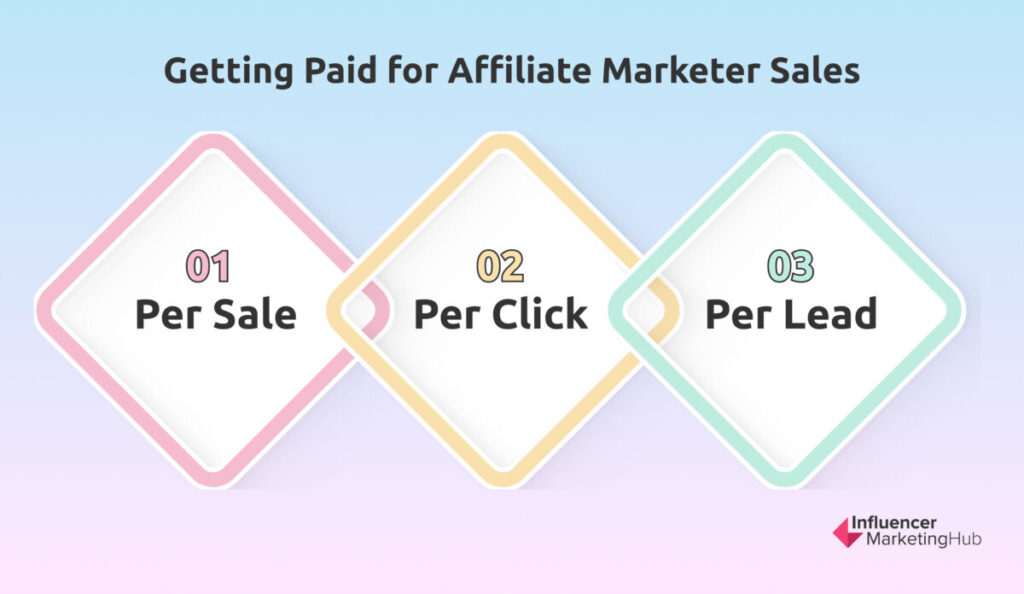

Per Sale
The Pay-per-Sale (PPS) model is the most popular and commonly used payment method in affiliate marketing. In this model, affiliates earn a commission each time a customer makes a purchase through their unique affiliate link. This commission is usually a percentage of the sale price, but it can also be a fixed amount per sale.
Advantages:
- High Earning Potential: Since commissions are tied to sales, affiliates can earn substantial amounts, especially when promoting high-ticket items.
- Aligned Interests: Both the merchant and the affiliate are motivated to drive sales, leading to a win-win situation.
Amazon’s affiliate program allows affiliates to earn a commission ranging from 1% to 10% depending on the product category. If an affiliate promotes a $500 electronic device and the commission rate is 5%, they will earn $25 for each sale made through their affiliate link.
Per Click
In the Pay-per-Click (PPC) model, affiliates get paid for the number of clicks they generate, regardless of whether those clicks result in sales. This model is less common because it poses a higher risk to merchants, who pay for traffic without guaranteed conversions.
Advantages:
- Easier to Achieve: Affiliates can earn money simply by driving traffic to the merchant’s site, without needing to convert those visitors into buyers.
- Increased Traffic: This model can help increase overall website traffic for the merchant, which may indirectly lead to more sales.
Example: If a merchant offers $0.50 per click, and your promotion generates 200 clicks, you will earn $100, irrespective of whether those clicks result in purchases.
Per Lead
The Pay-per-Lead (PPL) model compensates affiliates for generating leads, such as form submissions, sign-ups, or other predefined actions. This model is commonly used in industries where capturing leads is crucial, such as insurance, real estate, and online education.
Advantages:
- Steady Income Stream: Affiliates can earn a consistent income by focusing on generating qualified leads, which can be easier than driving direct sales.
- Valuable Leads: Merchants receive valuable leads that they can nurture and convert into customers over time.
HubSpot offers a PPL program where affiliates earn a commission for every free trial sign-up or demo request they generate. For example, HubSpot might pay $50 for each qualified lead that signs up for a free trial of their software. If an affiliate generates 10 qualified leads in a month, they will earn $500.
Hybrid Models
In addition to the primary models mentioned above, some affiliate programs use hybrid models that combine elements of PPS, PPC, and PPL. These models are designed to provide more balanced compensation and incentivize affiliates to engage in various promotional activities.
Advantages:
- Diversified Income: Affiliates can earn through multiple channels, such as clicks, leads, and sales, which can provide a more stable and diversified income stream.
- Increased Motivation: Affiliates are encouraged to engage in different types of marketing efforts, which can lead to higher overall performance.
ClickBank is an affiliate network that offers hybrid commission structures. Affiliates can earn a percentage of sales (PPS), get paid per click (PPC), or receive payments for leads generated (PPL). For instance, an affiliate might promote an online course with a 40% commission on sales, $0.20 per click, and $10 per lead. This allows affiliates to earn from multiple sources, enhancing their income potential.
Payment Logistics
Understanding how and when you get paid is crucial for managing your affiliate marketing business. Here are some common aspects to consider:
- Payment Frequency: Affiliate programs typically pay commissions on a monthly basis, but some may offer weekly or bi-weekly payments.
- Minimum Payout Threshold: Many programs have a minimum payout threshold that affiliates must reach before they can receive their earnings. For example, a program might require a minimum of $50 in commissions before issuing a payment.
- Payment Methods: Common payment methods include direct deposit, PayPal, checks, and wire transfers. Affiliates should choose programs that offer convenient and cost-effective payment options.
- Currency and Fees: Affiliates should be aware of the currency in which payments are made and any associated transaction fees, especially if they are working with international merchants.
How Much Do Affiliates Make?
The affiliate earnings can greatly vary based on factors such as the industry they’re in, the affiliate program they join, the commission rate, the price of the products they’re promoting, and their own marketing skills and audience size.
Here’s a simple formula to get a basic idea of how much an affiliate could potentially make:


For example, if an affiliate is in a program where they make 100 sales per month, the average sale price is $100, and the commission rate is 5%, their earnings would be:
Monthly Earnings = 100 sales/month x $100/sale x 0.05 = $500/month
However, this is a very simplified example. Real-world earnings can fluctuate widely based on the variables mentioned before.
Affiliates promoting high-ticket items or working in high commission rate programs (like digital products which often have commissions up to 50%) can earn significantly more. At the same time, those promoting low-priced items with a small commission rate and less traffic could earn much less.
Moreover, successful affiliates with a large audience or high conversion rate can make thousands to tens of thousands of dollars per month. Some super affiliates even earn six figures a year or more.
Affiliate Marketing Earning Potential
Below are key findings to help you understand the earning potential of affiliate marketing. These statistics are based on our 2023 Affiliate Marketing Benchmark Report:
- 3.7% of participants earned an affiliate income exceeding $150,000 annually.
- 7.94% of participants earned an affiliate income between $100,000 and $150,000 annually.
- 5.15% of participants earned an affiliate income between $50,000 and $100,000 annually.
- 16.21% earned an income between $10,000 and $50,000 annually.
- The majority, 57.75%, of participants earned an affiliate income of less than $10,000 annually.
While there’s great potential in affiliate marketing, it requires time, effort, and smart strategies to reach the higher earning brackets.
Common Types of Affiliate Marketing Channels
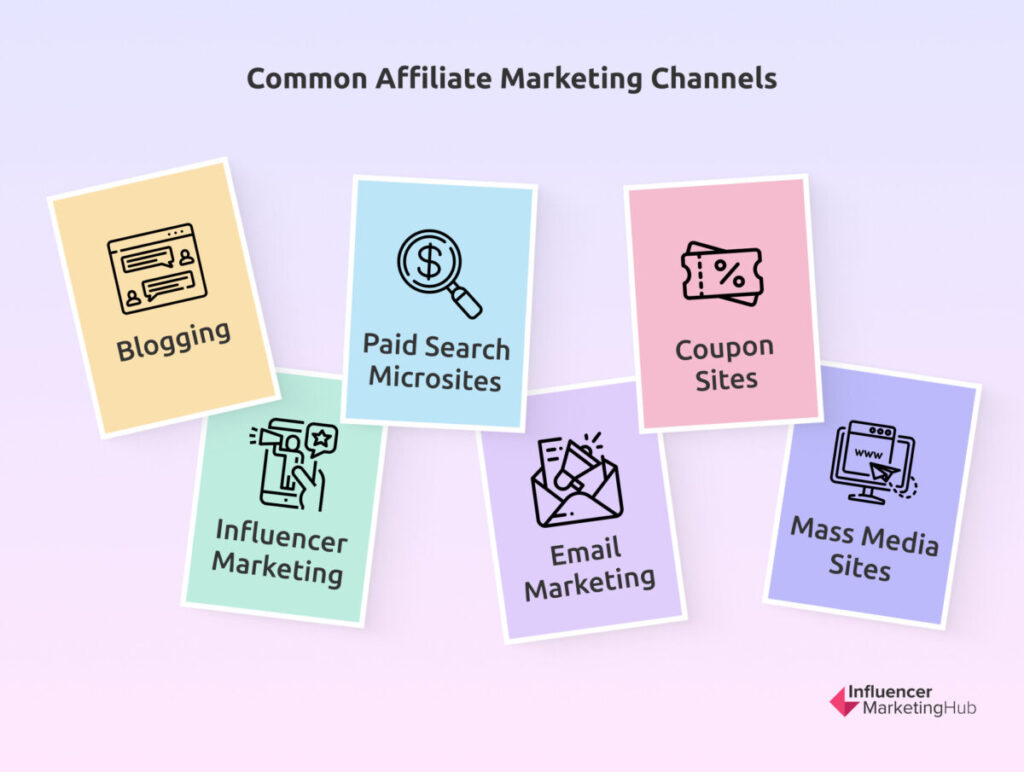

Affiliate marketers can bring in traffic and make sales in a number of ways. Of course, some affiliate marketing channels are more popular than others. In any case, try our affiliate marketing calculator to estimate approximate earnings per day, month, and year based on the traffic you receive from any channel and the conversion rate.
Here are some of our favorite marketing channels to succeed with affiliate marketing, along with their pros and cons:
Blogging
Blogging helps affiliates rank in search engine results and can drive traffic to affiliate offers organically (aka “free”). Typically, bloggers will use reviews, tutorials, how-tos, and other educational content to promote the affiliate product. They then link to the seller’s site using their unique affiliate link to get credit for the sale.
Smart Passive Income is a well-known blog by Pat Flynn, where he shares strategies and tips on how to create passive income streams. Through detailed guides, case studies, and reviews, Pat uses affiliate links to recommend tools and resources to his audience, earning commissions on sales generated through his blog.
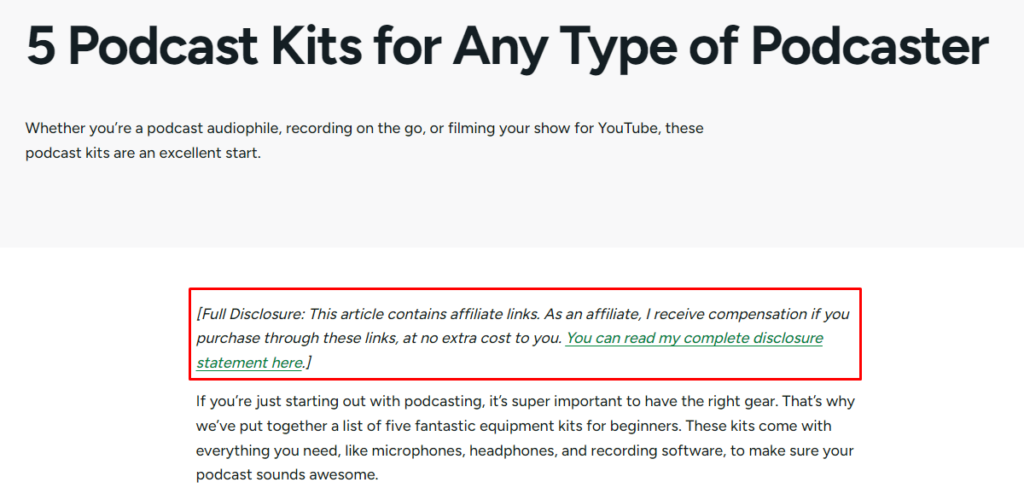

Source: Smart Passive Income
Pros:
- SEO Benefits: Well-written blogs can rank high in search engines, bringing in organic traffic over time.
- Authority Building: Regularly publishing quality content establishes you as an authority in your niche.
- Evergreen Content: Blog posts can continue to generate traffic and sales long after they are published.
Cons:
- Time-Consuming: Creating high-quality blog content takes time and effort.
- Delayed Results: It may take several months for blog posts to start ranking and generating traffic.
- Technical Skills: Requires some knowledge of SEO and content management systems.
Read also:
Read also:
Check out the How to Create Content that Actually Works: A Content Guide for Beginners
Check it out
Influencer Marketing
Influencer marketing platforms play a pivotal role in enhancing the efficiency and effectiveness of influencer marketing strategies. As you can probably imagine from a site named Influencer Marketing Hub, we’re big fans of influencer marketing. Influencers are people who hold a lot of sway over the people in their sphere of influence, typically on social media platforms like Instagram, YouTube, and Facebook. People follow influencers because they’re interested in what they have to say and are already primed to be open to trying whatever the influencer might promote.
Influencer marketing for affiliate sales can take many different forms like live videos, product reviews, account takeovers, and more.
Zoe Sugg, known as Zoella, is a British beauty and lifestyle influencer with millions of followers on YouTube and Instagram. She promotes various beauty and fashion products through her channels, often including affiliate links in her video descriptions and social media posts, driving significant traffic and sales for the brands she partners with.
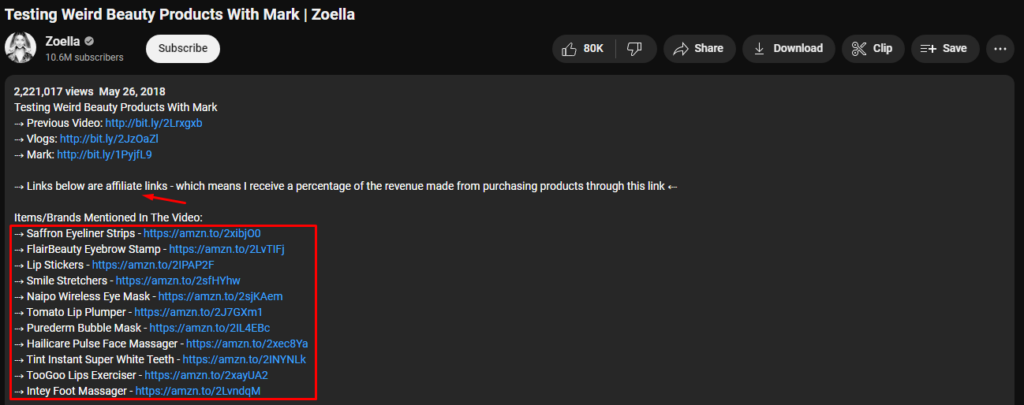

Source: Zoella
Pros:
- High Engagement: Influencers have a loyal and engaged following that trusts their recommendations.
- Instant Results: Influencer posts can generate immediate traffic and sales.
- Wide Reach: Potential to reach a large and diverse audience across multiple platforms.
Cons:
- Cost: High-profile influencers can be expensive to collaborate with.
- Reputation Risk: The influencer’s actions and reputation can impact your brand.
- Temporary Impact: Social media posts have a shorter lifespan compared to blog posts.
Read also:
Read also:
Check out the The Ultimate Influencer Marketing Strategy Guide
Check it out
Paid Search Microsites
Microsites are branded pages (or a single page) that are separate from your main website. These sites provide another avenue with which you can offer detailed information and a sales pitch for affiliate products. Since they’re separate from your main website, you can offer a more targeted, relevant message that’s free from the distractions that usually come with a traditional website.
Pros:
- Targeted Messaging: Allows for highly focused content and promotions.
- Improved Conversions: Can be optimized specifically for conversions.
- Brand Control: Full control over the content and design of the microsite.
Cons:
- Additional Costs: Setting up and maintaining a microsite involves extra costs.
- SEO Challenges: Microsites may not rank as well in search engines as main sites.
- Limited Traffic: Relies on paid search or direct traffic, which may be limited.
Email Marketing
Email marketing has been around for a long time, and for good reason. The ROI on email marketing is high. Like, really high. Depending on which study you read, numbers range from 3500%–4400% return. That means you have the potential to bring in $35–$44 of revenue for every $1 you invest in email marketing.
For affiliate marketers, your email list can be a great source of potential affiliate sales. While you don’t want to sell, sell, sell with every single email you send, there’s nothing wrong with sending a promotional email for every three value emails you send. You can add your affiliate links to your email newsletters and watch the affiliate sales roll in.
Pros:
- High ROI: Email marketing offers one of the highest returns on investment among marketing channels.
- Direct Communication: Allows for direct and personalized communication with your audience.
- Automation: Email marketing tools enable automation, saving time and effort.
Cons:
- List Building: Building a quality email list takes time and effort.
- Spam Risks: Poorly executed email campaigns can be marked as spam.
- Content Creation: Requires regular creation of engaging and valuable content.
Coupon Sites
Coupon sites have become increasingly popular in affiliate marketing since eCommerce and online shopping have taken off. Posting your affiliate links on coupon sites can bring in lots of sales from the savvy shoppers out there.
RetailMeNot is a popular coupon site that aggregates deals and discount codes from various retailers. Affiliates can earn commissions by posting their affiliate links on the site, attracting deal-hungry shoppers looking for discounts.
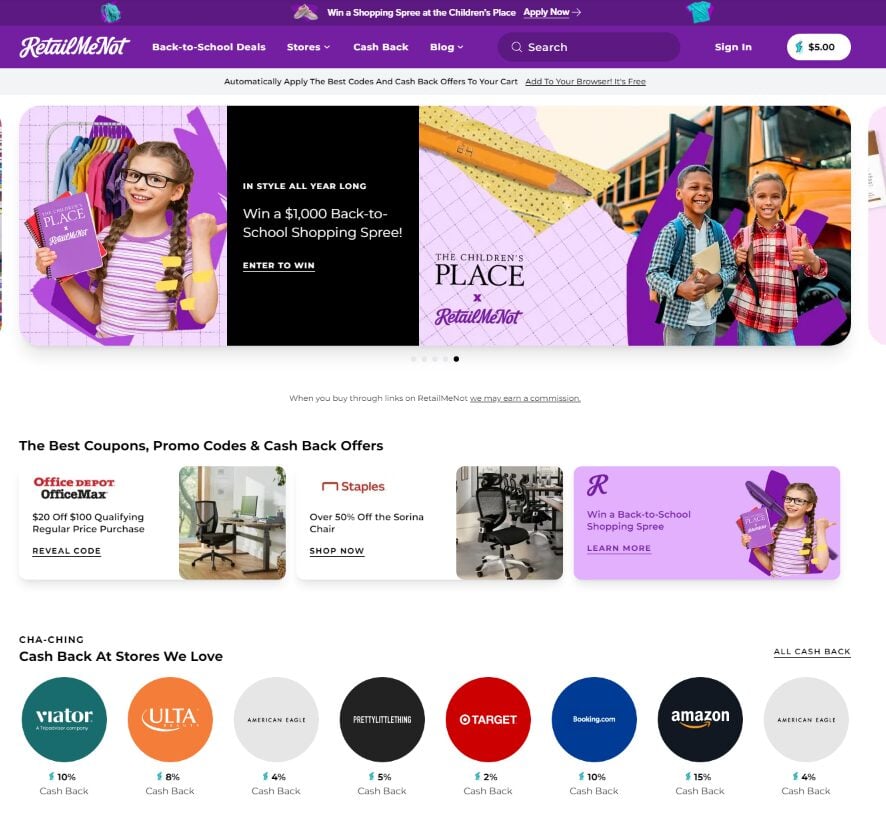

Source: RetailMeNot
Pros:
- High Traffic: Coupon sites attract a large number of visitors looking for deals.
- Conversion Boost: Discounts and deals can significantly increase conversion rates.
- Broad Audience: Potential to reach a wide audience across various demographics.
Cons:
- Low Margins: Heavy discounts can lead to lower profit margins.
- Brand Perception: Constant discounting can affect the perceived value of your brand.
- Competition: Highly competitive space with many merchants offering similar deals.
Mass Media Sites
Mass media sites, or large media sites, are built to bring in tons of traffic. On these sites, you’ll find reviews and comparisons of different products, many of which are affiliate products. These sites act as a depository of social proof for the products and services on them. They tend to promote products through banners and contextual affiliate links.
BuzzFeed frequently publishes listicles, reviews, and product roundups that include affiliate links. Their articles reach millions of readers, driving significant traffic and sales for the products they feature.
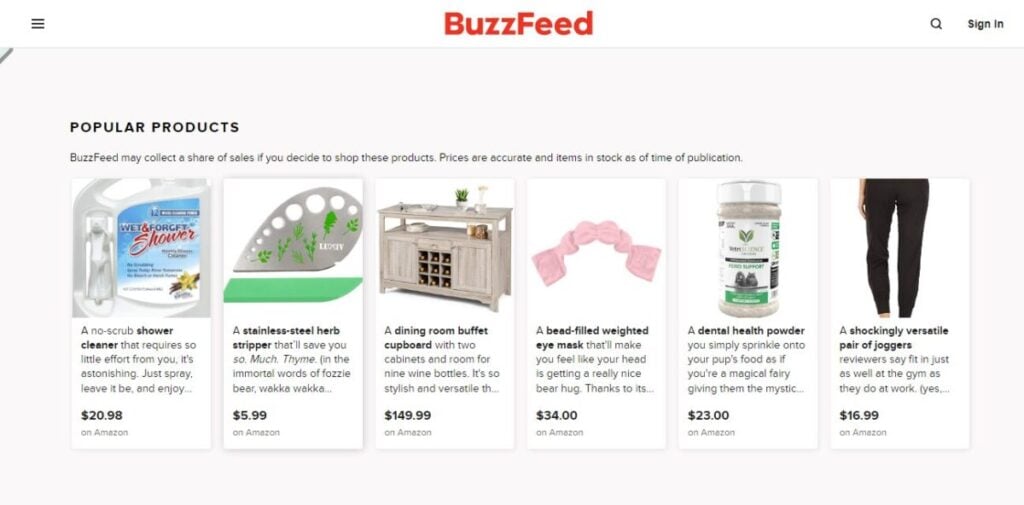

Source: BuzzFeed
Pros:
- High Visibility: Mass media sites have a large audience and high traffic volume.
- Social Proof: Reviews and comparisons add credibility and trust.
- Diverse Content: Ability to feature various types of content, such as articles, videos, and infographics.
Cons:
- High Competition: Competing for visibility among numerous other products and affiliates.
- Cost: Advertising and placement on mass media sites can be expensive.
- Control: Limited control over how your product is presented.
Benefits of Affiliate Marketing
Now that you know more about affiliate marketing, you may have noticed that it’s not exactly something you just turn on and it works. Affiliate marketing takes effort to get going. You’ll spend time creating content, attracting traffic to your landing pages or microsites, and promoting products on social media. The good news is that affiliate marketing offers several benefits. Let’s explore those benefits now.
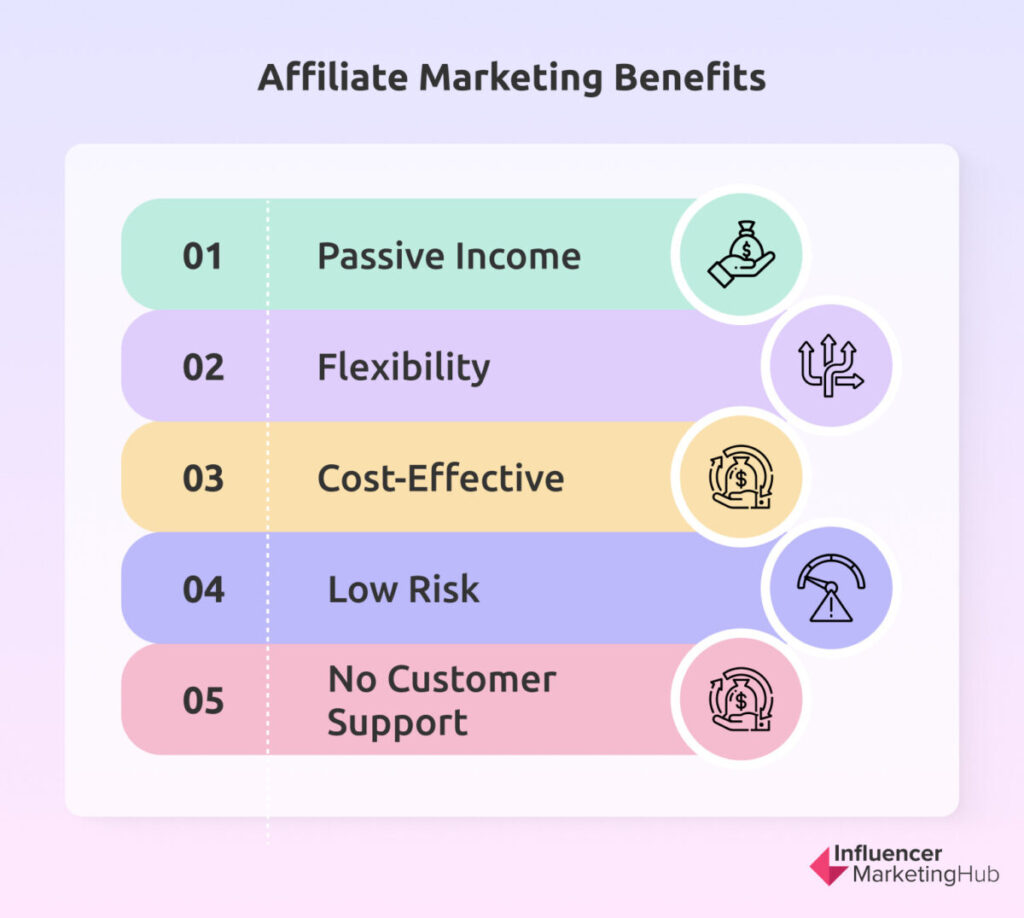

(Nearly) Passive Income
Outside of content creation and promotion, affiliate marketing can make you money at any time of the day or night, making it a nearly passive income option. And you don’t have to be actively participating in the transaction to make it happen. If you have a system set up to keep things running, you have the potential for a great return with very little ongoing effort.
Pro Tip: Automate Processes: Use automation tools for social media posting and email marketing to maintain regular engagement with minimal effort.
Flexibility
Affiliate marketing gives you incredible flexibility to do what you want and still bring in revenue for your business. You don’t have to create, produce, store, ship, or provide support for the product—you just sell it. That means you don’t have set hours for creating or promoting the product. You just choose products you like and that you think your audience will like, create the content to promote those products, and then do the actual promotion.
Diversify Your Portfolio: Promote a variety of products across different niches to maximize your income potential and reduce dependency on a single product or market.
Cost-Effective
If you’ve ever wanted to start your own business, especially one selling physical products, you know it costs money to get started. Sometimes, a lot of money. With affiliate marketing, you’ll have a low-cost way to start your own business. As an affiliate marketer, you only need to think of the time you’re investing to create content and promote.
Leverage Free Tools: Utilize free tools and resources for keyword research, content creation, and analytics to keep your startup costs low while optimizing your marketing efforts.
Low Risk
Continuing on from the previous benefit, affiliate marketing is also low risk. As an affiliate, you don’t have to put in money to create, produce, or store products. Your only job is marketing and promoting the products to your followers and paid traffic (if you choose to go that route).
Even if you decide to promote affiliate products via blogging, you’re not going to be dropping a ton of money on something that you’ll be out should it not work out. There are tons of affiliate products and services you can promote. If one is a dud, just move on to the next one.
Test and Pivot: Regularly analyze your affiliate performance data and be ready to pivot quickly to new products or strategies that show better potential.
No Customer Support
As an affiliate marketer, you don’t have to worry about customer support for the products and services you sell. This is a great relief to many affiliate marketers who want the freedom to start their own business without thinking about how to deal with actual customers.
The only thing we’d like to stress here is that the products you promote to your followers should be quality products or services that you would actually use. If you push bad products on your audience just to make a quick buck, they’re going to stop trusting you. So, be choosy with the affiliate products and services you promote.
Vet Products Thoroughly: Before promoting, test products yourself or rely on trusted reviews to ensure they meet quality standards, helping you maintain credibility with your audience.
Key takeaways
- Effort Required: Affiliate marketing requires time and effort to set up, including content creation, traffic attraction, and product promotion on social media.
- Nearly Passive Income: Once your system is running, affiliate marketing can generate income continuously without requiring constant active participation, making it a nearly passive income stream.
- Flexibility: Affiliate marketing offers significant flexibility, allowing you to choose products you believe in and create promotional content on your own schedule without the need for handling product logistics.
- Cost–Effective: Starting an affiliate marketing business is low-cost, primarily requiring an investment of time for content creation and promotion, rather than significant financial outlays.
- Low Risk: The financial risk is minimal since you don’t need to create, produce, or store products. You can easily switch to promoting different products if some don’t perform well.
- No Customer Support: Affiliates are not responsible for customer support, providing freedom from dealing with customer service issues. However, it’s crucial to promote high-quality products to maintain audience trust.
How to Get Started With Affiliate Marketing
Now that you know almost everything about affiliate marketing, all that’s left is to start. But how do you start with affiliate marketing?
A quick Google search of “affiliate marketing” brings up about 678 million hits. Even if you narrow that down to “how to get started with affiliate marketing,” you’re still going to find 88.5 million results. That’s a lot of content to wade through, especially since most of it is outdated, and a lot of what isn’t outdated starts in the middle of the process.
We’re going to start this affiliate marketing how-to guide from the beginning and share affiliate marketing practices so you can get started even if you don’t already know what a “cookie lifetime” is or why it’s important (don’t worry, we’ll tell you). Let’s dive in!
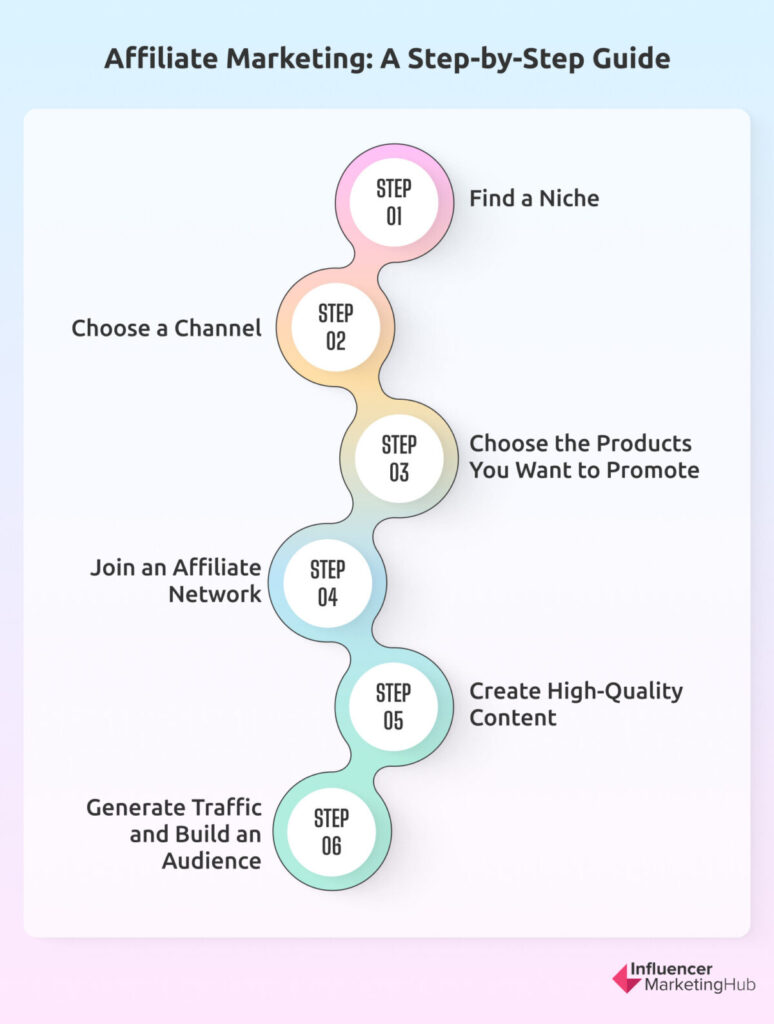

Step 1. Find a Niche
The very first step to getting started with affiliate marketing is to choose a niche (or “vertical” if you want to sound super knowledgeable). This niche is what you’re going to “stock your store” with. And we’re not going for a general store vibe here. As an affiliate marketer, you want to be known for something.
See our post about 200+ Affiliate Marketing Niches to get an idea.
This doesn’t mean that you only promote a single product or service, like golf balls. Instead, it means that you might become an affiliate for the broader golf niche. Within that niche, you could promote:
- Golf equipment like bags, clubs, and clothes
- Online learning and books
- Golf courses themselves, promoting memberships and day passes
- Professional golfing stuff like tournaments, golf history, memorabilia
You get the idea, right? Here are some of the verticals you might choose to explore:
- Hobbies like photography, travel, sports betting
- Financial products such as debt settlement, investing, credit cards
- Wellness topics like yoga, nutrition, organic products
- Lifestyle products like fashion, luxury items, online dating
- Home and family topics including home security, baby products, gardening
- Techy things like SaaS, web hosting, VPN
- Alternative products such as CBD, essential oils, personal development
Ask yourself, what are you passionate about? What do you, yourself, but? That’s an excellent place to start!
Step 2. Choose a Channel
After you’ve chosen your niche, you’ll want to choose at least one platform or channel you’re going to use for affiliate marketing. As we already mentioned, blogging is probably the easiest and cheapest way to get started with affiliate marketing and can work for affiliates who want to write product reviews and comparisons to promote their chosen affiliate products.
YouTube is another great platform for affiliate marketing. Plus, it’s free to start a YouTube channel, upload videos and orient toward YouTube affiliate marketing. The downside is that there are tons of other videos and creators on YouTube, so it can be hard to get attention to your products. Plus, it’s probably going to take a lot more time to create and upload a great video than it does to just write a blog post.
YouTube is definitely something to consider if you want to be on camera, talking to people. And, if you already have a following on YouTube, by all means, leverage it for successful affiliate marketing.
Instagram is another place where you’ll find a lot of affiliate marketing action. It’s a very active platform and, like YouTube, if you already have a following on the platform it’s an absolutely brilliant option. You can create visually appealing images and videos to promote your affiliate products and like other platforms, can even pay for ads if you want.
No matter what platform you choose, you’ll want to make it clear when you’re sharing a promotion. We recommend including affiliate link disclaimers with all of your links. So, on your blog, you’d link your affiliate product and then add “affiliate link” in parentheses. On YouTube, include your affiliate link disclaimer in your video description. For Instagram, using #ad or #sponsored is a great option.
Step 3. Choose the Products You Want to Promote
Now that you’ve chosen a niche and know where you want to promote your affiliate products, it’s time to choose the affiliate products you want to promote.
Choose products with your target audience in mind and make sure that you’re offering high-quality products that they will actually benefit from using. To know that you’re on the right track, ask yourself if the products you’re considering will improve the lives of the people you’re promoting them to. Is it something that you’d buy or would tell your grandma to buy?
If the product or service passes those two tests, you’ll want to make sure that it provides you a real chance to make money from promoting it. What do conversions and payouts look like for the product?
If nothing is coming to mind, or you just want to see what’s out there, you can head over to your favorite search engine, and search “your niche affiliate,” and go from there. Or…
Step 4. Join an Affiliate Network or Affiliate Program
If you have a website and are already creating content, you’re ahead of the game. You can use your site analytics to hone in on who your audience is so you can then find products that match them while also giving you the payout you want. Joining an affiliate network or affiliate program gives you access to brands that are looking for affiliates as well as tools you can use to find the right options. Some of the top affiliate networks include:
Affiliate networks will give you access to hundreds, if not thousands, of affiliate programs to join. An affiliate statistic says that 8 out of 10 brands run an affiliate marketing program, so the harder part is to make a selection from the many options available.
How to Choose the Best Affiliate Programs?
There’s a lot that goes into choosing the best affiliate program for you. Here are some of the more important factors to consider when choosing the best affiliate programs for you and your audience.
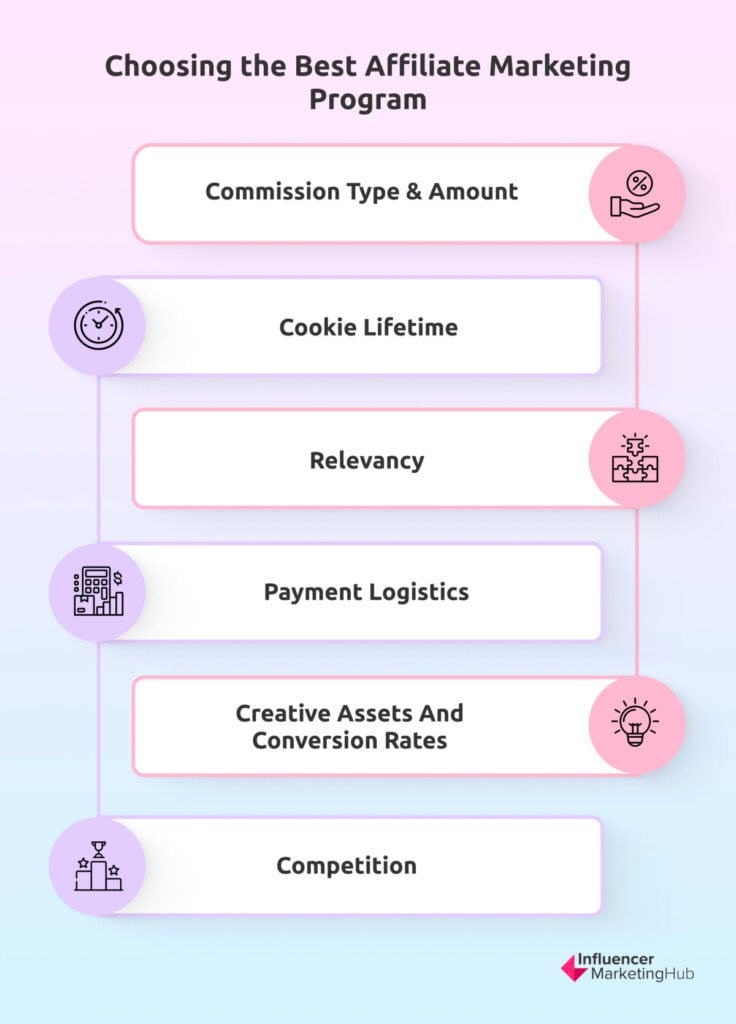

Commission Type & Amount
If you want to earn money with affiliate marketing, and we’d bet that you do, the commission type and amount you can earn are probably the most important factors for you. There are generally two types of commission structures: flat and recurring. The flat model is more common for physical products and involves a single, one-time flat payment per sale.
The recurring model is more popular with subscription products, so you get commissions each time the customer renews.
It’s important to find out about the brand’s refund policy, too. Refunds are an inevitable part of shopping. But what happens if someone buys through your affiliate link and then wants a refund? It’s important to know if you’re going to be charged back for refunds.
Cookie Lifetime
And here we are, back to the cookie lifetime that we mentioned earlier. When we talk about cookies on the internet, we’re referring to text files that contain small bits of data. These cookies are used to identify your computer as you use a network. When you’re considering affiliate marketing programs, you’ll want to know how long the cookie will stay on the shopper’s device. This is important because longer cookie lifetimes mean that you have a larger window of opportunity for a shopper to come back and make a purchase that will be attributed to you (so you get the commission).
So, if someone uses your affiliate link and the cookie lasts a day, the shopper would need to complete a purchase within 24-hours of accessing your affiliate link. If the cookie has a 30-day expiration, the shopper could make a purchase two weeks after first accessing your affiliate link and the purchase would still get credited to you. The longer the cookie, the better for you.
Relevancy
Your audience is vital to your success in most things. And that’s definitely the case for affiliate marketing. Choose products that are relevant to your audience. Finding products that are relevant to your audience and have high payouts is even better. But don’t choose a product that’s not right for your audience just because it has a high payout. You’ll not only damage the trust your audience has in you, but you likely won’t be making any sales.
Payment Logistics
How will you get paid? Make sure you understand how often the affiliate program pays out, where you’ll receive the money, and in what currency they pay. If you’re selling products with a recurring commission model, when do those payments get applied? Is there a specific threshold you have to meet in order to get paid (like, payouts only happen when there’s at least $50 in commissions)?
Creative/Promotional Assets and Conversion Rates
Much of the time, brands will offer creative assets like banners, graphics, and coupons you can use to promote their products. These can be incredibly helpful resources to use. Other brands might just give you a text link. Check out the resources that the brand provides. While just getting a link to promote might not be a deal-breaker, having to create these resources yourself, from scratch, needs to be factored into your costs.
It’s also important to check out what’s on the other end of the affiliate link. Is it a boring landing page filled with grammatical errors? A brilliantly designed video sales page? A landing page that looks like a box of “SALE!” stickers exploded all over it? The design of the page on the other end of the affiliate link can make a huge difference when it comes to your commissions. If the page isn’t built for conversions, it’s not likely to get many.
Competition
Another important thing to look at when choosing affiliate programs is competition. How many people are already selling the product? If the market seems overly saturated and the brand doesn’t seem large enough to support the drive for so many sales, you’re probably better off picking another option.
Step 5. Create High-Quality Content
Okay. You’ve chosen a vertical and a platform, identified products that you want to promote, and have even joined an affiliate network. You’re ready to go! But now what? It’s time for content creation.
The delivery of the content you create will vary depending on the platform or platforms you’ve chosen to use to promote your affiliate products, but there are a few types of content that you can depend on:
- Product Reviews: These are a staple in affiliate marketing and one of the easiest ways to get started. You can do your review as an article or a video, depending on the affiliate marketing channel you’re using. In your product review, share what you love and don’t love about the product (honesty is vital to keep your audience trusting you).
- Case Studies: These take the product reviews a step further. With case studies, you get to share a success story behind the product you’re promoting. It’s basically a “show” instead of “tell” type of promotion.
- Tutorials: How-to articles and videos are great for letting your audience know how you use an affiliate product or how you did something cool with it. Tutorials are actionable content and set your audience up for success.
- Product Comparisons: In a product comparison, you’d compare your affiliate product with another product designed to do the same thing and then share your honest opinion. It’s quite possible that the affiliate product won’t be the best in some use cases even if it is overall the best product. Being honest just lets your audience know they can trust you.
- A Resource Page: These aren’t usually big drivers of sales, but they can be a way to get some additional income from affiliate marketing. Plus, it’s super easy to create a page that has all of the products you recommend and affiliate links for those products, so why not just do it?
Step 6. Generate Traffic and Build an Audience
Once you’ve created some content, you’re ready to start generating traffic and building an audience that will come to click your affiliate links. There are three specific affiliate marketing strategies we recommend.
Build an Email List
We’ve already told you about email marketing’s ROI so it should come as no surprise that we recommend you build an email list. Unlike your list of social media followers, you own your email marketing list. So, if your social network decides to stop letting people use it for promotion, you’ll still have access to your email list and can use that whenever you want.
The fastest way to grow your email list is by offering a lead magnet (something users get in exchange for giving you their email address). This might be a checklist, a free course, or any number of things that your audience finds useful and valuable. Once you have their info, you can send subscribers valuable content along with promotional emails.
To get the most from your email marketing, you’ll probably want to check out our picks for the top email marketing platforms that will make the entire process easy.
Search Engine Optimization
Search Engine Optimization (SEO) is important for getting organic traffic to your site. The idea is pretty simple: you target specific keywords that your target audience is interested in, create content on those topics, and make sure your site is indexed by Google, Bing, and whichever other search engines you want.
Paid Traffic
Once you start bringing in money, you can reinvest some of it in paid traffic. You just create an ad (on a search engine or social media platform) and it draws people into your site. While it’s not a guarantee that you’ll get affiliate sales, it’s still a great way to build traffic and potentially get your site ranked higher so it’s found more often by the people who are interested in what you have to offer.
Tips to Level Up Your Affiliate Marketing
Now you know all the basics to get started with affiliate marketing (and some not-so-basics, too). What’s next? You get started, of course! Here are some tips that will help you get started and level up your affiliate marketing efforts quickly.
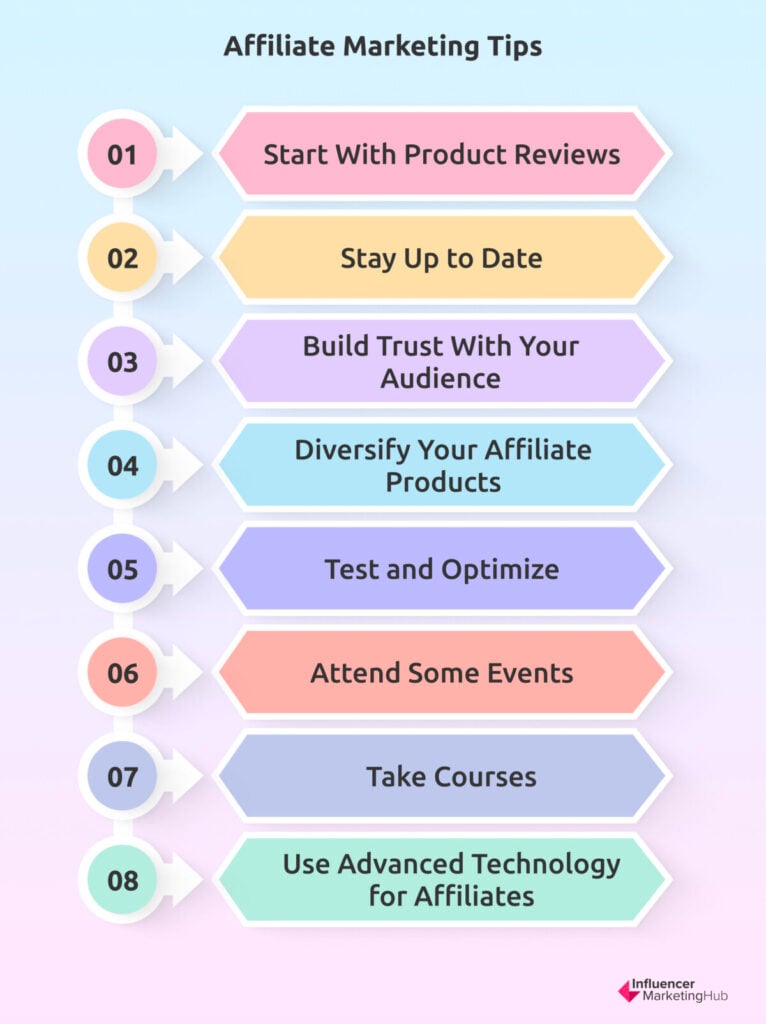

1. Start With Product Reviews
Start by reviewing products and services in your vertical. This will build trust with your audience and establish you as an expert in your niche. Be sure to let your audience know why they would benefit from the products you’re reviewing (or why they should stay away from them). Once you have some product reviews under your belt, add product comparisons into the mix.
2. Stay Up to Date
There’s tons of competition online and in affiliate marketing. To be the best, you’ll need to stay up on the affiliate marketing trends, not only in your vertical but with marketing in general. If you’re a master of social media, you don’t want to be left behind when the next TikTok hits the scene.
Finally, I suggest following some of the top affiliate marketers in the game such as Gael Breton, Spencer Haws, or Matt Diggity. They may occasionally sell some courses or services, but their major income comes from affiliate marketing.
3. Build Trust With Your Audience
We’ve said it quite a few times in this article: trust with your audience is paramount. Don’t betray that trust by pushing products that they don’t want or need. Instead, focus on products that you truly believe will benefit your audience. And never directly tell them to buy—you’re recommending products based on your expert opinion. Be helpful and recommend quality to keep your audience coming back again and again.
4. Diversify Your Affiliate Products
You don’t need to limit yourself to the affiliate products you promote. While you may have a particular seller that you love, it’s fine to work with other sellers and promote other products, too. This also protects you as the affiliate since you won’t be left high and dry if the seller you love decides to cut commissions, limit the ways you can reach out to your audience about products, or eliminate their affiliate program altogether.
5. Test and Optimize
Test and optimized everything. All the time. Become intimately familiar with your analytics and use those analytics to inform your marketing and promotion. In marketing, you never really know for sure how something is going to work until you do it. So, let things run for a little while to gather data and then start tweaking. Pay attention to what performs better and do more of that.
6. Attend some events
Attending affiliate marketing events offers invaluable exposure to the industry. You get the opportunity to learn from experts, understand emerging trends, and network with like-minded professionals. Such events provide a platform for gaining insights and establishing relationships that can lead to successful partnerships and collaborations. They also inspire and motivate you by showcasing successful stories, making them a worthwhile investment for budding affiliate marketers.
7. Take Courses
Affiliate marketing courses are another incredibly beneficial tool in the hands of affiliate marketers. They provide a structured way to understand and navigate the complexities of affiliate marketing, from understanding SEO and digital marketing strategies to creating engaging content.
Courses can also help decode consumer behavior, allowing marketers to tailor their campaigns more effectively to their target audience. Plus, ongoing learning helps marketers stay abreast of the latest trends and changes in the industry, essential for long-term success.
8. Use advanced technology for affiliates
Affiliate marketing software platforms serve as a powerful tool for affiliates. Just as you aren’t confined to promoting a single affiliate product, similarly, you’re not limited to manually tracking performance or depending on a single affiliate program. These platforms offer rich tracking features, broad program selection, and automation, mirroring the diversity and protection you need. If one avenue seems less promising, the platform provides others to explore.
This ensures you’re never stuck in a tough spot, just like having various sellers to promote safeguards your affiliate interests. These platforms truly embody a safety net and a springboard, providing an integrated solution for your affiliate marketing journey.
See our extensive guide about affiliate marketing tips and strategies to learn more.
Get Started With Affiliate Marketing Today!
You now have everything you need to get started with affiliate marketing. You could even get up and running today, right now, if you wanted! Through the education, tips, and step-by-step process we’ve outlined here, we have no doubt that you’ll be able to launch your career as an affiliate marketer in no time. So, what are you waiting for? Get started!
Frequently Asked Questions
What Is Affiliate Marketing?
Affiliate marketing is a performance-based marketing tactic in which a seller rewards individuals with a commission for each customer referred or product sold through the individual’s promotional activities.
How do I earn money with affiliate marketing?
Find products you want to sell and promote them using your affiliate link through a combination of channels like blogging, social media, and paid ads.
Who Can Be An Affiliate Marketing Program Seller?
Anybody! If you have a product or service to sell and the means to offer commissions to people to promote it for you, you can start your own affiliate marketing program.
How do I know what’s popular?
There are several tools that can help you spot trends (like BuzzSumo), but your best bet is to get to know your target audience. You can even ask them what products they’d like to see you review or talk about and go from there.
How do I find products and companies to promote?
Joining an affiliate marketing network is the easiest way to find products and companies to promote, but you can also search “your niche + affiliate” on search engines to find other ideas.
How do I promote affiliate products?
You can promote affiliate products through product reviews, product comparisons, in your email newsletter, on your blog, through paid ads, and more.



